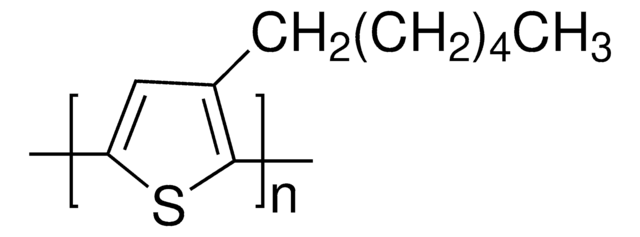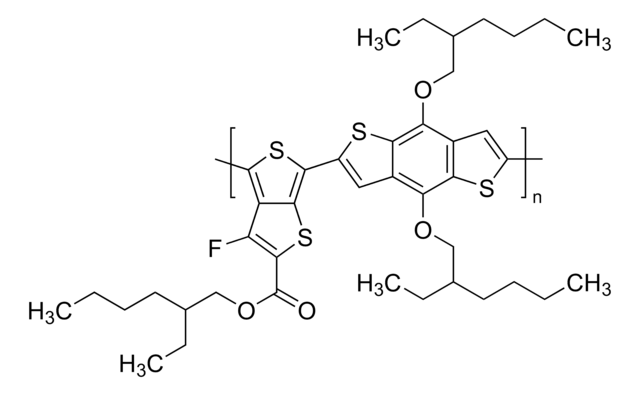772410
PTB7
average Mw 80,000-200,000, PDI ≤3.0
Synonym(s):
Poly({4,8-bis[(2-ethylhexyl)oxy]benzo[1,2-b:4,5-b′]dithiophene-2,6-diyl}{3-fluoro-2-[(2-ethylhexyl)carbonyl]thieno[3,4-b]thiophenediyl})
About This Item
Recommended Products
description
Band gap: 1.84 eV
Quality Level
form
solid
mol wt
average Mw 80,000-200,000
greener alternative product characteristics
Design for Energy Efficiency
Learn more about the Principles of Green Chemistry.
sustainability
Greener Alternative Product
solubility
chlorobenzene: soluble
chloroform: soluble
dichlorobenzene: soluble
λmax
680 nm (thin film)
Orbital energy
HOMO -5.15 eV
LUMO -3.31 eV
Mw/Mn
2.4 +/- 0.6
PDI
≤3.0
greener alternative category
, Enabling
1 of 4
This Item | 754005 | 901099 | 753963 |
|---|---|---|---|
| description Band gap: 1.84 eV | description Band gap: 1.75 eV | description Band gap: 1.8 eV, Limited solubility in CHCl3 | description - |
| mol wt average Mw 80,000-200,000 | mol wt average Mw 7,000-20,000 | mol wt Mw >50,000 by GPC (GPC standard: PS) | mol wt Mw 20,000-80,000 |
| greener alternative product characteristics Design for Energy Efficiency | greener alternative product characteristics - | greener alternative product characteristics Design for Energy Efficiency | greener alternative product characteristics Design for Energy Efficiency |
| sustainability Greener Alternative Product | sustainability - | sustainability Greener Alternative Product | sustainability Greener Alternative Product |
| solubility chlorobenzene: soluble | solubility - | solubility chlorobenzene: soluble, dichlorobenzene: soluble | solubility - |
General description
Application
OPV Device Structure: ITO/PEDOT:PSS/PTB7 :PC71BM/Ca/Al
- JSC = 14.9 mA/cm2
- VOC = 0.75 V
- FF = 0.69
- PCE = 7.4%
Storage Class Code
11 - Combustible Solids
WGK
WGK 3
Flash Point(F)
Not applicable
Flash Point(C)
Not applicable
Choose from one of the most recent versions:
Already Own This Product?
Find documentation for the products that you have recently purchased in the Document Library.
Articles
The development of high-performance conjugated organic molecules and polymers has received widespread attention in industrial and academic research.
Organic photovoltaics (OPVs) represent a low-cost, lightweight, and scalable alternative to conventional solar cells. While significant progress has been made in the development of conventional bulk heterojunction cells, new approaches are required to achieve the performance and stability necessary to enable commercially successful OPVs.
Professor Chen (Nankai University, China) and his team explain the strategies behind their recent record-breaking organic solar cells, reaching a power conversion efficiency of 17.3%.
Active Filters
Our team of scientists has experience in all areas of research including Life Science, Material Science, Chemical Synthesis, Chromatography, Analytical and many others.
Contact Technical Service







![[6,6]-Phenyl C71 butyric acid methyl ester, mixture of isomers 99%](/deepweb/assets/sigmaaldrich/product/structures/716/624/9fb9f2f0-ae99-429f-8d3a-b12267976a4d/640/9fb9f2f0-ae99-429f-8d3a-b12267976a4d.png)


